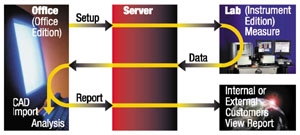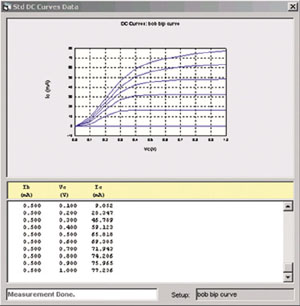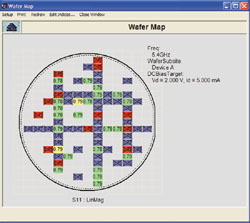Product Feature
Software for Optimizing the Design and Low Cost Production of Waveguide Filters
Zeland Software Inc.
Fremont, CA
Because of their low loss and high power-handling capability, waveguide filters have been widely used in telecommunications and wireless communications systems. The key to gaining a competitive edge in the market is both a winning design and low cost production. A newly released Coupled-cavity Filter software, COCAFIL, allows design engineers to master the key. Uniquely, COCAFIL allows optimized design of millimeter-wave waveguide bandpass filters using standard wires that are ideal for low cost production.
COCAFIL features an extremely friendly graphical user interface. Effectively, the software completes a simulation of a filter with given frequency parameters and dimensions within seconds, and produces an optimized design of a filter per designer specifications within a couple of minutes on a Windows PC.

Fig. 1 Simulated vs. measured response of a C-band pseudo-high-pass filter.
COCAFIL's Advantages
COCAFIL has significant advantages over other software, including the capability that both bandpass filters and pseudo-high-pass filters can be treated. Both simulation and synthesis can be performed. Built-in genetic-algorithm (GA)-based optimization is included in synthesis. A variety of coupling structures, such as circular posts, square posts, E-plane strips, diaphragms and transverse strips can be chosen to meet different requirements. In addition, low cost millimeter-wave waveguide bandpass filters using standard wires can be designed.
|
|
|
|
Fig. 2 Simulated vs. measured response of an E-band E-plane filter. |
Fig. 3 Simulated and MoM-based data for a two-post filter. |
Experimental Verification
To verify COCAFIL's accuracy, extensive experimental verifications have been performed.
Figure 1 compares COCAFIL's simulation with the measured response of a C-band pseudo-high-pass filter. This filter consists of six resonators coupled by diaphragms. The simulation agrees with Young and Schiffman's measurements, where a = 34.85 mm, t = 0.508 mm, w1 = w7 = 4.125 mm, w2 = w6 = 5.26 mm, w3 = w5 = 6.02 mm, w4 = 6.325 mm, d1 = d6 = 15.392 mm, d2 = d5 = 16.082 mm, d3 = d4 = 16.612 mm.1 In contrast, Figure 2 shows the response of an E-band bandpass filter using E-plane strips. Again, COCAFIL's simulation agrees closely with the measured data obtained by Vahldieck and his colleagues, where a = 3.045 mm, w = 0.1 mm, t1 = t4 = 0.613 mm, t2 = t3 = 1.978 mm, d1 = d3 = 1.911 mm, d2 = 1.917 mm.2 Finally, Figure 3 depicts COCAFIL's simulation together with method-of-moments-based data of a two-post bandpass filter with waveguide width = 8.636 mm, post diameter = 2.59 mm, post separation = 8.099 mm.3 Although for this last filter the effect of an appreciable difference between the two curves is felt, the actual shift of the center frequency is only 0.5 percent and the agreement between the two is considered to be close enough by a practical standard. These comparisons have not only verified the software but also demonstrated its capability in treating various coupling structures.

Fig. 4 Synthesis setup for a Ka-band filter.
Low Cost Millimeter-wave Bandpass Filters
To illustrate COCAFIL's unique feature for the design of low cost millimeter-wave bandpass filters using standard wires, two such design examples are presented. To the company's knowledge, there is no other software with this useful feature. The procedure involves two steps. First, COCAFIL optimizes post diameters and separations against given filter specifications. Then, a user chooses the closest standard wire diameters in place of the optimized post diameters and lets COCAFIL re-optimize the post/wire separations.

Fig. 5 The Ka-band filter's synthesized dimensions and frequency response.
The first design is a Ka-band filter. Figure 4 shows COCAFIL's synthesis setup and the synthesized dimensions and filter response are shown in Figure 5 .
The second design is a W-band filter. Figures 6 and 7 display COCAFIL's synthesis setup and synthesized dimensions and filter response, respectively.

Fig. 6 Synthesis setup for a W-band filter.

Fig. 7 The W-band filter's synthesized dimensions and frequency response.
Conclusion
A waveguide filter software, COCAFIL, has been described and verified through extensive comparisons with measurements. It has significant advantages over other software. Its unique feature for design of low cost millimeter-wave bandpass filters using standard wires has been stressed.
References
1. L. Young and B.M. Schiffman, "A Useful High-pass Filter Design," Microwave Journal , Vol. 6, No. 2, February 1963, pp. 78-80.
2. R. Vahldieck, J. Bornemann, F. Arndt and D. Grauerholz, "Optimized Waveguide E-plane Metal Insert Filters for Millimeter-wave Applications," IEEE Transactions on Microwave Theory and Techniques , Vol. 31, No. 1, January 1983, pp. 65-69.
3. P.G. Li, A.T. Adams, Y. Leviatan and J. Perini, "Multiple-post Inductive Obstacles in Rectangular Waveguide," IEEE Transactions on Microwave Theory and Techniques , Vol. 32, No. 1, April 1984, pp. 365-373.
Zeland Software Inc., Fremont, CA (510) 623-7162.
Circle No. 301


